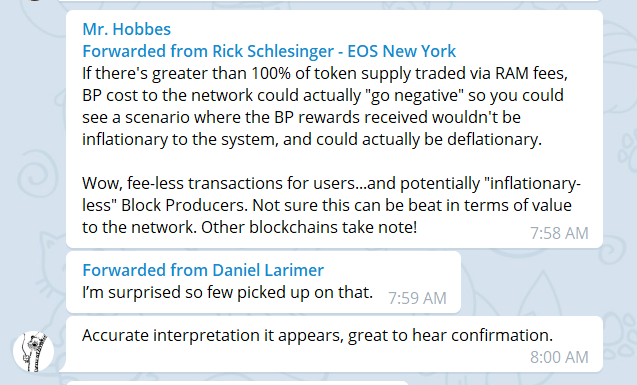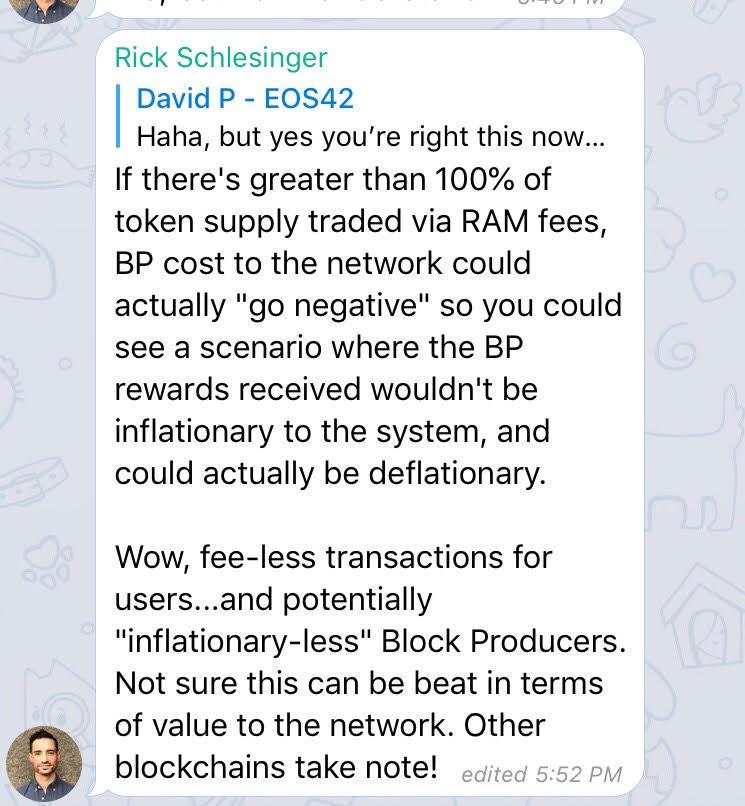Block Producers can potentially be zero cost to the network
This article is co-written by @EOSNewYork and @EOSnation and is based on the recent Dawn 4.0 announcement made by Block.One on 5/4/18. The content contained herein is subject to change as the EOS.IO software is developed.
Don’t worry, Mr. Hobbes. We haven’t missed a thing.
Marginal Costs
In economics, marginal cost is the cost of producing one additional unit of a product or service. In the latest EOS.IO release, Dawn 4.0, Block.One has introduced mechanisms to offset the cost of block production and trend the marginal cost of securing and validating the network toward zero. This important and eloquent solution cannot be understated. Let us explain…
Today, one can send a picture across the internet and have it propagate to millions, even billions, of users. Besides the cost of a phone and data plan purchase, the act of sending the picture costs the user fractions of one cent. The user can effectively perform the action itself for near zero marginal cost, and we could even reasonably say it was “free”.
The costs of transmitting information on blockchain networks can vary. Depending on the economic model and incentive structure, these costs can be relatively high. These costs, usually in the form of inflation and transaction fees, are transferred directly onto the users who have no choice but to accept them. Blockchain use cases, like an Internet-of-Things, are rendered unobtainable by these fees.
RAM Allocation Model
The recent announcement of EOS.IO Dawn 4.0 describes a new RAM allocation model which introduces the possibility for RAM itself to be a speculative vehicle. In order to avoid this, Block.One is imposing a 1% fee on all purchases of RAM. Please note that this is a fee for trading RAM only and is not the same as a “transaction fee”. All transactions on EOS are still fee-less.
Now that there is a RAM market, speculators may want to trade RAM price-volatility for profit. The EOS.IO system contract makes RAM non-transferrable and charges a 1% fee on trades. The result of this fee is to offset the natural inflation of tokens by taking them out of the market.
These tokens are removed from circulation and are effectively destroyed.
Offsetting the Cost of Block Production
On the other hand, we have 1% of total token supply going to block producers in the form of rewards. The block reward, or any incentive to secure a public blockchain, is a necessity. If there isn’t some form of incentive for network validators then there is no network. While the cost of validating blocks to the user is minimal, they are still costs. But what if we could offset those costs? The 1% fee for RAM attempts to do just that.
If [the] annual trading volume of RAM equals the token supply then 100% of all block producer rewards will be covered by the RAM market fees.
What Dan is essentially saying here is that as the number of RAM trades increases, the fees incurred could not only equal the 1% block producer reward but possibly exceed it. This reduces overall inflation and as the network grows, the marginal cost of block production trends toward zero.
Uncharted Economic Territory
We are witnessing the first glimpses of what a zero marginal cost network may look like. This great EOS experiment isn’t going to just deliver free transactions for its users, but it will also help propel our understanding of zero marginal cost economics.
Full disclosure: we cannot predict the future. Things are moving quickly as we approach Launch Day. We think this is an elegant economic solution, but in practice it may function very differently. But we hope that this explanation will help spark conversations on the topic of marginal costs and how EOS can impact the way we conduct commerce.
This post was co-authored by @EOSNation and @EOSNewYork and inspired by conversations that were held in Telegram with @EOS42 and @EOSVibes in an effort to understand the new Market-Based RAM Allocation Model of EOS.IO Dawn 4.0. Please join the discussion and let us know your thoughts on the new economic model.
%20copy.png)






Dafuq EOS? Enough with the innovations! Give your competitors a chance!
Not just blowing the competition out of the water... but taking the water as well.

Lol
potentially a lot of things could happen in the world, no wars, no famine, yet...
so yeah, EOS has amazing potential, let's do the best we can to fulfill it.
Really agree with your vision. So much peace and prosperity can be had and we're so close to having the tools and mechanisms to achieve such a wonderful world.
Go EOS! I'm hodler until I give those tokens to my grandchildren!
This was pretty much the only thing EOS was lacking when it comes to token supply. Glad to see them fix it by creating a potential for deflation.
What's stopping someone from buying up all the RAM and creating a monopoly on the RAM?
Nice one
thx for this great post.. i can't wait for EOS to launch.. I hope you see my article about the eos hackaton. Will not copy it here. but if you like it and resteem it it would be awesome
Almost everybody is expecting EOS to be something magnificent. Everything should be in place before lunch date.
What I still don't understand is why RAM is singled out here. Yes it's important, but so are other resources. In fact, the more important a resource is, the more critical price discovery becomes.
By limiting transactions compared to other resources, RAM becomes un-economized to that degree.
Good post, gracias por compartirlo :)